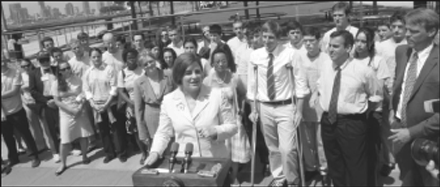By Josh Rogers
“Step outside,” the senior citizen said, challenging a police commander Monday night. After all, some Downtowners have dealt with Holland Tunnel traffic longer than others.
The man, who has lived all of his 66 years in the neighborhood now known as Soho, was not threatening the officer at the community meeting, he just wanted the commander to see what the late-day rush hour is like every night on Broome St. Outside the Puffin Room gallery, crossing pedestrians weaved through mostly idling cars backed up to Mercer St. as the drivers slowly inched the six long blocks to the free ride through the tunnel to New Jersey. West Broadway and other cross streets were equally jammed.
The lanky, bald senior, who declined to give his name, was angry like many others in the room when the commander, Deputy Inspector Michael Pilecki, who has been in charge of traffic police in Lower Manhattan since 9/11, seemed unaware of the problem.
Councilmember Alan Gerson, who had organized the town hall forum on traffic, had just asked Pilecki what needed to be done to get traffic agents on Broome St. Pilecki congratulated Gerson for taking the first step — letting police know about the problem.
This triggered catcalls from the audience, who were shocked that Pilecki was first learning about the situation.
“It wasn’t brought to your attention before?” one man shouted out. “It’s been going on for years.”
People called out nearby streets that also needed attention — Spring, Varick and others. When one resident asked for a commitment to put traffic agents along Broome St. by this weekend, Pilecki said he couldn’t take that many officers off other busy streets, such as Canal, but he did promise he would put an agent at the most jammed intersection, Broome and W. Broadway.
Although there has been a lot of news coverage about Mayor Bloomberg’s traffic-pricing plan in recent weeks — and this was a group of people who cared enough about traffic to show up at the meeting — congestion pricing was hardly mentioned. Judging by questionnaires distributed by Gerson, who has not taken a position on the mayor’s plan, a solid majority of the 30 or so in the room supported congestion pricing.
Bloomberg’s plan would impose a flat $8 fee on rush-hour car drivers ($21 for trucks) entering Manhattan streets south of 86th St., in an effort to reduce pollution and raise money for mass transit investment.
City Council Speaker Christine Quinn, whose district includes Hudson Square, the Village and Chelsea, announced her support for the mayor’s plan Monday, coincidentally a few hours before the traffic meeting.
Gerson steered clear of the subject Monday night, although he did suggest he was in favor of a new traffic policy, saying “the political stars are aligned” for a change. He is planning traffic town halls in other parts of his district, which also includes part of the Village, Chinatown and Manhattan south of Canal St.
Carl Rosenstein, the Puffin Room’s owner, spoke of “Bloomberg’s courageous congestion-pricing idea,” a statement which drew neither positive nor negative reactions from the otherwise lively audience. People seemed more interested in getting relief this week rather than the end of next year, the earliest the pricing plan would go in effect if it is passed.
One woman who complained about circling around for an hour to drive home because traffic agents prevent her from turning on certain streets, asked if local residents could have more leeway than other motorists.
“I’m sure we can come up with a way to do that,” Pilecki told her.
The commander said the mayor wants to add 110 traffic agents across the city and Pilecki hopes to get some more in Lower Manhattan. Residents at the meeting said the agents along Canal St. are helpful. Pilecki also hopes Albany passes a bill to downgrade gridlock violations to the equivalent of parking violations, which ironically would make them easier to enforce, he said. If blocking the box is not a moving violation, it will enable agents to issue tickets automatically to the vehicle owner, rather than the driver, and the officers would not have to appear in traffic court to justify the tickets, Pilecki explained.
Susan Stoltz, 55, another Soho resident, said road rage from drivers sitting in traffic is also a problem.
“What do I do when someone threatens to kill me with their truck?” she asked Pilecki. “How do I cross the street?”



































